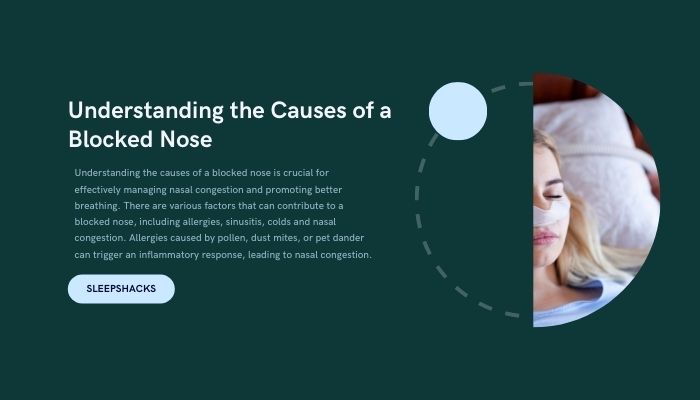Struggling with a blocked nose? Learn the optimal sleeping position to alleviate congestion and improve your sleep quality. Find effective remedies and expert tips for a better night’s rest.
A good night’s sleep is essential for maintaining overall well-being and promoting optimal physical and mental health. Adequate rest rejuvenates the body, enhances cognitive function, and improves mood. However, when faced with a blocked nose during sleep, the quality of sleep can be significantly compromised.
Nasal congestion caused by allergies, sinusitis, colds or other factors can lead to restless nights, snoring, and discomfort. Breathing becomes difficult, causing interruptions in sleep patterns and leaving individuals feeling fatigued and irritable during the day. Understanding the impact of a blocked nose on sleep quality underscores the importance of finding effective solutions, such as identifying the best sleeping position, to ensure uninterrupted breathing and restful nights.
By addressing nasal congestion and optimizing sleep posture, individuals can experience improved sleep quality, enhanced well-being and a refreshed start to each day.
Understanding the Causes of a Blocked Nose.
Understanding the causes of a blocked nose is crucial for effectively managing nasal congestion and promoting better breathing. There are various factors that can contribute to a blocked nose, including allergies, sinusitis, colds and nasal congestion. Allergies caused by pollen, dust mites, or pet dander can trigger an inflammatory response, leading to nasal congestion.
Sinusitis an infection or inflammation of the sinus cavities, can also result in a blocked nose. Additionally, common colds and respiratory infections often cause nasal congestion as a symptom. Its important to identify the underlying cause of a blocked nose in order to implement targeted treatments and find relief.

By understanding these causes, individuals can take appropriate measures to alleviate nasal congestion, improve airflow and ultimately enhance their sleep quality and overall well-being.
During sleep, various factors can contribute to a blocked nose, impeding smooth airflow and causing discomfort. Allergies, such as hay fever or allergic rhinitis can trigger an immune response, leading to nasal inflammation and congestion. The presence of allergens like pollen, dust mites, or pet dander can exacerbate these symptoms, making it difficult to breathe freely while asleep. Sinusitis, characterized by inflammation of the sinus cavities, can also contribute to a blocked nose during sleep. Infections or irritants can cause the sinus linings to swell, leading to nasal congestion. Additionally, common colds and respiratory infections can cause nasal passages to become congested, particularly when mucus production increases.
These factors collectively contribute to nasal obstruction during sleep, disrupting the normal breathing process and affecting sleep quality. Understanding how these factors impact nasal congestion during sleep is crucial in finding effective remedies and ensuring restful nights.
The Best Sleeping Position for Unblocking the Nose
Discovering the best sleeping position for unblocking the nose can significantly improve breathing and enhance sleep quality. One recommended sleeping position for relieving nasal congestion is sleeping with the head slightly elevated. By propping up the upper body with an extra pillow or using an adjustable bed, gravity helps to reduce the accumulation of nasal fluids and promotes better drainage.
This position can also alleviate pressure on the sinuses, allowing for easier breathing. Sleeping on the side is another beneficial position, as it helps to open up the nasal passages and prevents the tongue from obstructing airflow.
By adopting the best sleeping position for unblocking the nose, individuals can experience improved nasal airflow, reduced congestion, and a more comfortable sleep. Experimenting with different positions and finding the one that works best for individual needs can make a significant difference in promoting easy breathing and restful nights.
Step-By-Step Instructions for Achieving the Recommended Sleeping Posture.
Achieving the recommended sleeping posture for unblocking the nose is a simple process that can enhance breathing and promote better sleep. Follow these step-by-step instructions to optimize your sleep posture. Firstly, gather a few pillows or cushions to provide the necessary elevation. Start by lying on your back and place a pillow or two under your head, raising it slightly to create a gentle incline. This elevation helps to prevent nasal fluids from accumulating and facilitates better drainage. Next, consider placing an additional pillow under your upper back and shoulders for added support.
This slight elevation can further alleviate pressure on the sinuses and promote improved breathing. If you find it comfortable, try sleeping on your side with a pillow between your knees to maintain proper spinal alignment. This position helps to open up the nasal passages and prevents the tongue from obstructing airflow. Remember to adjust the height and number of pillows according to your personal comfort level.
By following these step-by-step instructions and customizing the recommended sleeping posture to suit your preferences, you can optimize your sleep position for unblocking the nose and enjoy easier breathing throughout the night.
Additional Sleeping Tips for Blocked Nose Relief
In addition to adopting the recommended sleeping position for blocked nose relief, there are several additional tips that can further alleviate nasal congestion and promote better sleep. Consider using nasal strips, which are adhesive strips placed across the nose to help widen the nasal passages and improve airflow.
Nasal saline sprays or rinses can also be beneficial, as they help moisturize and clear the nasal passages, reducing congestion. Creating a humid environment in the bedroom can provide relief by adding moisture to the air and preventing nasal dryness. This can be achieved through the use of a humidifier or by placing a bowl of water near the bed.
Propping up additional pillows can provide extra elevation and support, further assisting with sinus drainage and reducing congestion. It is also advisable to keep the bedroom clean and free from allergens by regularly dusting, vacuuming, and washing bedding to minimize potential triggers.
By incorporating these additional sleeping tips into your routine, you can enhance the effectiveness of the recommended sleeping position and find relief from blocked nose symptoms, allowing for a more restful and rejuvenating sleep.
Required Materials for Improving Sleep with a Blocked Nose
Improving sleep with a blocked nose often requires the use of certain materials that can aid in relieving nasal congestion and promoting better breathing. One essential item is a nasal saline spray or rinse, which helps to moisturize the nasal passages and clear away mucus, reducing congestion. These sprays are readily available at pharmacies and can provide quick relief. Another valuable material is a humidifier, which adds moisture to the air and helps prevent dryness in the nasal passages.
By maintaining optimal humidity levels in the bedroom, a humidifier can alleviate nasal congestion and promote easier breathing. Additionally, specialized pillows designed to support the head and neck can provide added comfort and help maintain an optimal sleeping position. These pillows are often contoured to provide better support and alignment, reducing the likelihood of snoring and facilitating improved airflow.
Considering these required materials for improving sleep with a blocked nose and incorporating them into your sleep routine can contribute to a more comfortable and restful night’s sleep, allowing for easier breathing and enhanced overall well-being.
The Benefits of Sleeping in the Right Position
Sleeping in the right position offers numerous benefits that can positively impact overall sleep quality and well-being. By adopting the recommended sleeping position, individuals can experience improved breathing and reduced nasal congestion. This leads to better oxygenation of the body, enhancing overall respiratory function and reducing the likelihood of snoring. Proper sleep posture also helps to align the spine, reducing the risk of discomfort and promoting better spinal health.
Additionally, sleeping in the right position can aid in digestion by facilitating the natural movement of food through the digestive system. This can prevent issues such as acid reflux and indigestion that may disrupt sleep. Moreover, the correct sleeping position can contribute to reduced muscle tension and joint pain, allowing for a more restful and comfortable sleep. By optimizing sleep posture, individuals can wake up feeling refreshed, rejuvenated, and ready to take on the day.
Incorporating the benefits of sleeping in the right position into your sleep routine can lead to significant improvements in overall sleep quality, ensuring a healthier and more energized lifestyle.
Can You Prevent Blocked Nose While Sleeping?
Preventing a blocked nose while sleeping is possible by implementing certain strategies and maintaining a healthy sleep environment. While it may not be entirely avoidable in all cases, there are steps you can take to minimize the chances of experiencing nasal congestion during sleep. First and foremost, keeping the bedroom clean and free from dust, allergens, and irritants can help reduce the risk of nasal congestion. Regularly dusting, vacuuming and washing bedding can help create a more allergen-free sleeping environment.
Using a humidifier in the bedroom can also be beneficial, as it adds moisture to the air, preventing nasal dryness and congestion. Additionally, avoiding known allergens, such as pet dander or pollen, can help reduce the likelihood of triggering a blocked nose. Maintaining good nasal hygiene, such as using saline sprays or rinses to keep the nasal passages moist, can also contribute to preventing nasal congestion during sleep.
It’s important to note that underlying medical conditions or allergies may still cause occasional blocked noses during sleep, but by implementing these preventive measures, you can significantly reduce the frequency and severity of nasal congestion, leading to better sleep and overall well-being.
FAQs
which sleeping position is best for blocked nose?
The best sleeping position for a blocked nose is sleeping with the head slightly elevated. By propping up the upper body with an extra pillow or using an adjustable bed, gravity helps to reduce the accumulation of nasal fluids and promotes better drainage.
This position can alleviate pressure on the sinuses and allow for easier breathing. Sleeping on the side can also be beneficial, as it helps open up the nasal passages and prevents the tongue from obstructing airflow. It’s recommended to experiment with different positions and find the one that works best for individual needs in order to promote easy breathing and achieve restful nights.
